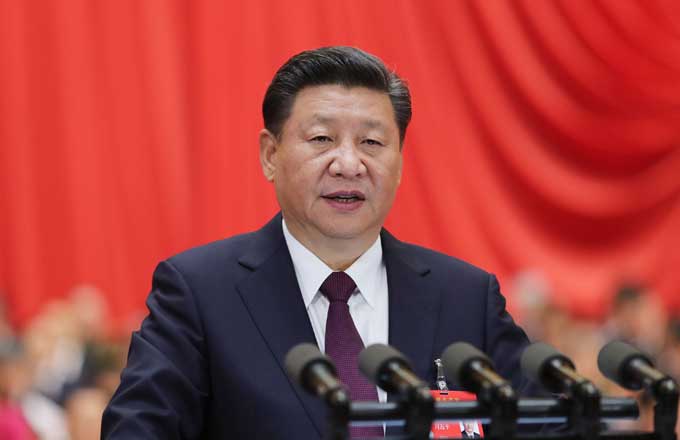Witnesses' account of Xinjiang terror attacks
More than one week after rioters killed 24 people at Lukqun Township in northwest China's Xinjiang Uygur autonomous region, the charred walls of a police station still serve as a painful reminder of that violent morning on June 26.
What happened on that bloody morning? Who were the rioters? What have caused a series of violent terrorist attacks in Xinjiang?
Over the past week, Xinhua reporters conducted extensive interviews with victims, witnesses, officials and experts to uncover more details of the terror attacks.
Bloody slaughter
Lukqun Township in Shanshan County is well known for its abundant melon and grape production. The police station, government building and the office building of the special patrol squadron are located from west to east along the township's main artery, with stores dotting both sides of the road.
At this time of year, local people usually start their day early in order to dodge the temperatures that begin to soar around noon. At dawn of June 26, about 1,000 workers gathered near a crossroad in the town center, waiting to pick and transport fruit.
|
 A religious figure in Lukqun Township gives an interview on the June 26 terrorist attack in Xinjiang. Zhen Shixin For China Daily |
No one could have known what was about to happen. Around 6 a.m., truck driver Liu Fei from Korla City in southern Xinjiang was awakened by noise outside. Through his windows, he saw flames spurting from the police station across the road and a chaotic scene on the street crowded with people.
Shortly after, he saw a group of people run out of the police station, wielding long knives. They jumped onto a motorized tricycle and piled into a black Volkswagen Santana sedan and rushed toward the township government building, followed by another group of shouting young people, some of whom were wearing masks.
What shocked Liu most was a human head in a pool of blood in the middle of the street.
The violent terrorist attack was the most severe since the July 5, 2009 riots that resulted in 197 deaths in Xinjiang's capital of Urumqi.
The police station was only the rioters' first target. They attacked the office building of the special patrol squadron, the township government building, a construction site, a private store and a beauty saloon. They also set fire to multiple cars and motorcycles.
Abulimit, a retired teacher who used to be up early, on that day was killed while trying to stop the rioters from attacking a pedestrian with their wielding long knives.
A security guard also saw the atrocities and alerted police. He was also killed while trying to stop the rioters.
The rioters also attacked a construction site, killing a number of workers there.
According to public security authorities, 24 people, including two females, were killed in the attack. Of the victims, 16 were ethnic Uygurs and eight were of Han ethnic. The attacks also left 21 others injured.
On the afternoon when Xinhua reporters arrived at Lukqun, the wreckage of charred or damaged cars, police vehicles and motorcycles could be seen along the road and in the yards outside the targeted buildings.
The shrouded bodies of some victims were lain in the backyard of the police station. A police officer told reporters that at least five victims were beheaded.
"The bodies of the police officers and civilians were all gathered here to be taken away, while the rioters' bodies were put in another place. We must not lay their bodies together," the police officer said, bursting into tears.
The terror attack shocked local communities, as the region of Turpan Prefecture that administers Shanshan County has witnessed fast development in recent years, and local people live a relatively well-off life.
"We are living a paradise-like life. But on that day, I saw the scenes of hell," said Suleyman, an ethnic Uygur who has lived in the township for more than three decades.
Masterminded terror attacks
Police investigations suggest that the multiple attacks in Shanshan on June 26 was a premeditated and organized violent terrorist crime.
Before the violent attack, rioters had internalized religious extremism spread by foreigners, carried out secretive and illegal religious activities, watched terrorist video footage, purchased criminal tools and familiarized themselves with the environment surrounding the targets, according to police investigations.
The way the attacks were carried out and the horror the perpetrators inflicted on the public was similar to the terrorist attacks in other countries, as the perpetrators were deluded by overseas terrorist organizations who incited them to action and scouted the targets multiple times ahead of the attack.
Police have learned that a group of people headed by Ahmatniyaz Sidiq and Eli Ahmatniyaz, both from Lukqun Township, began to illegally gather and watch terrorist video footage and listen to audio programs from the terrorist group East Turkistan Islamic Movement (ETIM) that spread so-called "jihad" principles.
After becoming religious extremists, they actively recruited members for a 17-member group to carry out illegal religious activities. Meanwhile, they mulled terrorist attacks and conspired to go abroad to participate in the "jihad," according to police.
Before the attack, two extremists from Kuqa County in southern Xinjiang mobilized the group to carry out a "jihad." As they considered it would be too difficult to go abroad, they instead planned to stage the violent attacks locally.
The evidence shows that, in plotting the attack, Eli Ahmatniyaz and some other members said clearly on June 20 that they wanted to "start a 'jihad' and do something big."
They set the town's police station and the special patrol squadron as their initial attack targets, then they would attack local government buildings and residents.
They raised funds and purchased 26 long knives, 21 daggers and 310 liters of gasoline. They also made 28 petrol bombs.
Police evidence shows that before the incident, some members of the gang conducted several scouting missions around the township government building, the police station and nearby places under the instigation of Eli Ahmatniyaz.
On June 26, the rioters staged the mobile attack, driving the motorized tricycle and the hijacked Santana car.
"I have seen that man before, as he often showed up on the street recently. I never thought that he was plotting such evil deeds," said a witness who had recognized the driver of the motorized tricycle. The witness preferred not to be name over fears of terrorists taking revenge.
The attacks unfolded in a way that many local people did not even think of.
Around 1:00 a.m. on that day, 16 rioters gathered for a religious ritual and they rushed to a gas station in three motorized tricycles and forced staff there to fill their cans with gas around 3:00 a.m.
Around 5:50 a.m., the rioters assaulted the police station in Lukqun and the township government building, axing officers, burning buildings and crashing cars.
While carrying out the attacks, the terrorists tried to kill everybody they saw along their way, attacking a beauty salon and a construction site, killing and injuring innocent people, including ethnic Uygurs.
The local government and police immediately launched counter-attacks. They killed 11 rioters and arrested four others. Many knives and gas cans used by the terrorists were confiscated.
"The attacks were well planned. The rioters wanted to get rid of law enforcement officers first and then attack the government and the civilians," said a wounded Uygur policeman, Askar, who gunned down several rioters.
- Anti-terror drill staged in Xinjiang
- Xinjiang offers rewards for tips
- CPC paper urges to safeguard stability in Xinjiang
- Xinjiang to reward terrorism whistleblowers
- Xinjiang violence reaction across Chinese media
- 19 detained for spreading rumors in Xinjiang
- Fugitive of Xinjiang attack captured
- Government pledges to clamp down on terrorism in Xinjiang
- Official urges 24-hour patrol in Xinjiang
- Xinjiang vows to maintain stability
- Foreign Ministry rejects US claims on Xinjiang





















